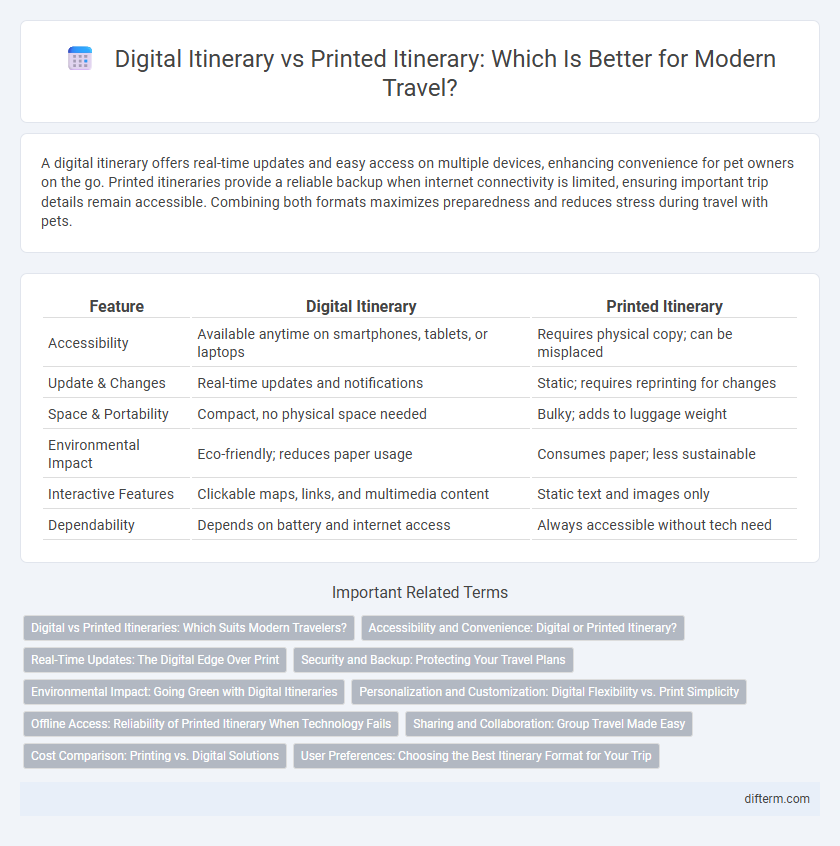A digital itinerary offers real-time updates and easy access on multiple devices, enhancing convenience for pet owners on the go. Printed itineraries provide a reliable backup when internet connectivity is limited, ensuring important trip details remain accessible. Combining both formats maximizes preparedness and reduces stress during travel with pets.
Table of Comparison
| Feature | Digital Itinerary | Printed Itinerary |
|---|---|---|
| Accessibility | Available anytime on smartphones, tablets, or laptops | Requires physical copy; can be misplaced |
| Update & Changes | Real-time updates and notifications | Static; requires reprinting for changes |
| Space & Portability | Compact, no physical space needed | Bulky; adds to luggage weight |
| Environmental Impact | Eco-friendly; reduces paper usage | Consumes paper; less sustainable |
| Interactive Features | Clickable maps, links, and multimedia content | Static text and images only |
| Dependability | Depends on battery and internet access | Always accessible without tech need |
Digital vs Printed Itineraries: Which Suits Modern Travelers?
Digital itineraries offer real-time updates, easy access on multiple devices, and eco-friendly benefits, making them highly practical for modern travelers who prioritize convenience and sustainability. Printed itineraries provide a tangible backup when technology fails or connectivity is limited, appealing to those who prefer physical documentation and offline access. Choosing between digital and printed formats depends on individual travel habits, destination connectivity, and the need for immediate itinerary modifications.
Accessibility and Convenience: Digital or Printed Itinerary?
Digital itineraries offer unparalleled accessibility by allowing travelers to access their plans anytime via smartphones or tablets, eliminating the risk of losing important documents. Printed itineraries provide convenience for those in areas with limited internet connectivity or prefer tangible copies for quick reference. Both formats enhance travel efficiency, but digital options often support real-time updates and interactive features, making them more adaptable to changing travel conditions.
Real-Time Updates: The Digital Edge Over Print
Digital itineraries offer real-time updates that printed versions cannot match, ensuring travelers receive instant notifications about flight changes, gate updates, or weather disruptions. This immediate access to live information enhances travel flexibility, reducing the risk of missed connections and delays. Mobile apps and cloud-based platforms empower users with dynamic scheduling that adapts seamlessly to evolving travel conditions.
Security and Backup: Protecting Your Travel Plans
Digital itineraries offer enhanced security features such as encryption and password protection, reducing the risk of unauthorized access to sensitive travel information. Automatic cloud backups ensure your travel plans are safely stored and easily retrievable if your device is lost or damaged. Printed itineraries, while immune to cyber threats, are vulnerable to physical loss or damage, making digital copies essential for reliable backup and protection.
Environmental Impact: Going Green with Digital Itineraries
Digital itineraries significantly reduce paper consumption, contributing to lower deforestation rates and minimizing waste in landfills. Electronic formats also cut down on carbon emissions associated with printing, shipping, and disposing of physical documents. Embracing digital itineraries supports sustainable travel practices by promoting resource efficiency and reducing travelers' overall environmental footprint.
Personalization and Customization: Digital Flexibility vs. Print Simplicity
Digital itineraries offer unparalleled personalization and customization, allowing travelers to easily modify schedules, add real-time updates, and integrate maps or local recommendations directly on their devices. Printed itineraries provide simplicity and tangibility, enabling quick reference without battery dependency or screen distractions, ideal for those who prefer a straightforward, unchanging travel plan. Travelers seeking flexibility often favor digital formats, while those valuing ease and reliability lean toward printed versions.
Offline Access: Reliability of Printed Itinerary When Technology Fails
Printed itineraries offer unmatched reliability for offline access during travel, ensuring important trip details remain available without internet connectivity or device power. Digital itineraries rely heavily on smartphone battery life and network signals, which can be inconsistent in remote areas or during technical malfunctions. Travelers who prioritize uninterrupted access to schedules, addresses, and reservations benefit from carrying a physical copy as a fail-safe backup.
Sharing and Collaboration: Group Travel Made Easy
Digital itineraries streamline sharing and collaboration, enabling real-time updates and seamless group access across devices. Travelers can easily coordinate plans, share notes, and adjust schedules collaboratively, reducing miscommunication and enhancing trip coordination. Printed itineraries lack these dynamic features and require manual distribution, limiting flexibility in group travel settings.
Cost Comparison: Printing vs. Digital Solutions
Digital itineraries significantly reduce costs by eliminating the need for paper, ink, and printing equipment, making them an eco-friendly and budget-conscious option. Printed itineraries incur expenses related to high-quality paper, color printing, and frequent updates, which can lead to recurring costs for travelers. Choosing digital solutions enhances cost efficiency while providing real-time updates and easy accessibility on smartphones and tablets.
User Preferences: Choosing the Best Itinerary Format for Your Trip
User preferences for digital vs. printed itineraries often hinge on convenience and accessibility; digital itineraries offer real-time updates and easy sharing, while printed formats provide reliability in areas with limited internet connectivity. Travelers who rely on mobile apps like TripIt or Google Trips tend to favor digital versions for seamless integration with calendars and navigation tools. Conversely, printed itineraries appeal to those who prefer tangible copies for quick reference without device dependency during travel.
digital itinerary vs printed itinerary Infographic

 difterm.com
difterm.com